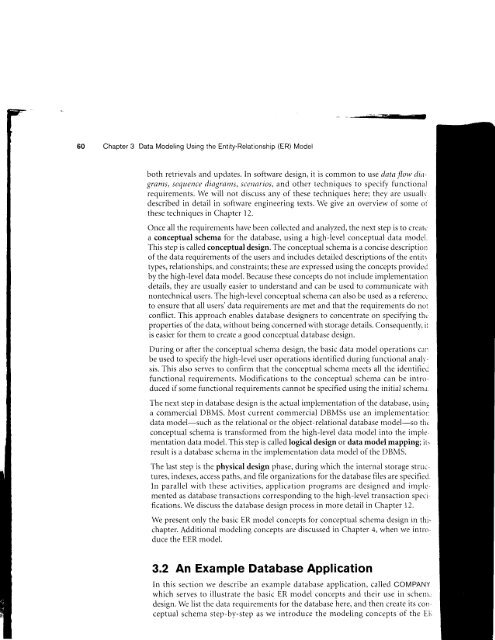this pdf excerpt
this pdf excerpt
this pdf excerpt
You also want an ePaper? Increase the reach of your titles
YUMPU automatically turns print PDFs into web optimized ePapers that Google loves.
Chapter 3 Data Modeling Using the Entity-Relationship (ER) Model<br />
both retrievals and updates. In soflware design, it is common Io use dsta Jlow diagronts,<br />
sequence diagrttms, scartorios, and other techniques to specify functional<br />
requirements. We lvill not discuss any of these techniques here; they are usr.rallr<br />
described in detail in software engineering texts. We give an overview of some ot<br />
these techniques in Chapter 12.<br />
Once all the requirements have beer-r collected and analyzed, the next step is to crt'atr'<br />
a conceptual scherna for the database, using a high-level conceptual data rnodel.<br />
This step is called conceptual design. The conceptual schema is a concise description<br />
of the data requirements of the users irnd includes detailed descriptions of the entitr<br />
types, relationships, and constraints; these are expressed using the concepts provided<br />
by the high-level data model. Because these concepts do not include implementation<br />
details, they are usr.rally easier to understand and can be used to communicate rvith<br />
nontechnical users. The high-level cor-rceptual schema can also be used as a referencc<br />
to ensure that all users'data requirements are met and that the requirements do nor<br />
conflict. This approach enabies database designers to concentrate on specifing thc<br />
properties of the data, without being concerned rvith storage details. Consequently, it<br />
is easier fbr them to create a good conceptual database design.<br />
During or after the conceptuirl schema design, the basic data model operations can<br />
be used to specily the high-level user operations identified during tirnctional analr -<br />
sis. This also serves to confirm that the conceptual schema meets all the identifiec<br />
functional requirements. Modifications to the conceptual schema can be introduced<br />
if some functional requirements cannot be specified using the initiai schenra<br />
The next step in database design is the actual implementation of the database, usins<br />
a commercial DBNrlS. Most current commercial DBMSs use an implementatior:<br />
data model-such as the relational or the object-relational database rnodel-so th.<br />
conceptual schema is transformed from the high-level data model into the implementation<br />
data model. This step is called logical design or data model mapping; it.<br />
result is ar database schema in the implementation clata model of the DBMS.<br />
The last step is the physical design phase, during which the internal storage strLrctures,<br />
indexes, access paths, ar-rd file organizations for the database files are specified.<br />
In parallel with tl-rese activities, application programs are designed and implcmented<br />
as databirse transactions corresponding to the high-level transaction speci<br />
fications. We discuss the database design process in more detail in Chapter 12.<br />
We present only the basic ER n-rodel concepts for conceptutrl schema clesign in thi.<br />
chapter. Additional modeling concepts are discussed in Chapter 4, when we intro'<br />
duce the EER model.<br />
3.2 An Example Database Application<br />
In <strong>this</strong> section we describe an example database application, called COMPANY<br />
which serves to illustrate the basic ER model concepts and their use iu schenr.<br />
design. We list the data requirements for the database here, and then create its conceptual<br />
schema step-by-step as we ir-rtroduce the modeling concepts of the EIi














